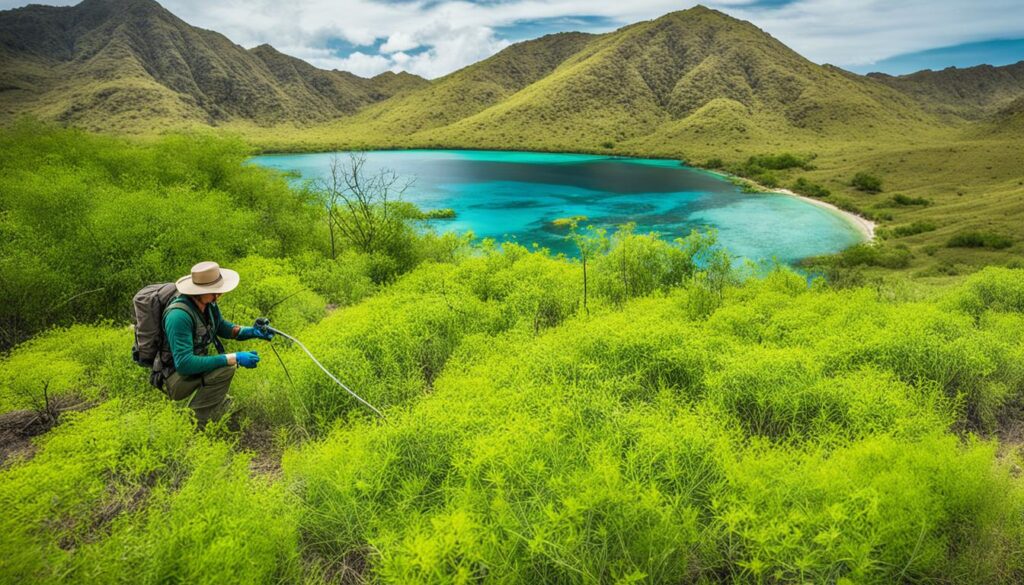Start an amazing journey to Labuan Bajo, Indonesia. See the stunning Komodo National Park’s beauty. You’ll find amazing landscapes, colorful sea life, and the famous Komodo dragons.
Labuan Bajo is the door to the park. It’s full of natural wonders and rich sea life. You can dive into the local culture, see old villages, and learn about their traditions.
Don’t miss the lively markets. They offer fresh seafood and exotic fruits. It shows what daily life is like in the community.
Key Takeaways
- Explore the wonders of Komodo National Park, a UNESCO World Heritage Site renowned for its diverse ecosystem and iconic Komodo dragons.
- Discover the unique blend of natural beauty, rich culture, and thriving marine life that makes Labuan Bajo and Komodo National Park a must-visit destination.
- Learn about the challenges of protecting the delicate balance of the park’s ecosystem, including the management of invasive weed species.
- Gain insights into the efforts to conserve the Komodo dragons and their habitats, ensuring the survival of this remarkable species.
- Understand the significance of sustainable tourism and its role in preserving the natural wonders of Komodo National Park.
Introduction to Komodo National Park
Location and Geography
Komodo National Park is in the heart of the Indonesian archipelago. It’s a place of stunning nature and lots of life. The park includes islands like Komodo, Padar, and Rinca, and many small ones. It’s between Sumbawa and Flores islands, where the ocean currents meet.
This spot is full of life because of the strong currents. Labuan Bajo on Flores is the main way to get into the park. It’s a lively town that shows off the local culture. It’s a great place to start your adventure in the park.
| Fact | Value |
|---|---|
| Total Area of Komodo National Park | 173,000 hectares |
| Land Area | 33.76% |
| Sea Area | 66.24% |
| Proposed Extension Area | 2,321 square kilometers |
| Number of Fish Species | Over 1,000 |
| Number of Coral Species | Around 260 |
| Number of Sponge Species | 70 |
The Komodo National Park was made in 1980. It’s a special place in the Indonesian archipelago. Visitors can see its wonders and dive into the rich life of this unique area.
The Invasive Weed Species in Komodo
Komodo National Park is a UNESCO World Heritage Site known for its unique plants and animals. It faces a big problem: invasive weeds that could harm its ecosystem. These weeds can take over the native plants, threatening the Komodo dragon and other animals.
A study in Ontoloe Island found many invasive weeds. It found 72 plant species, with some being very common. Leucaena leucocephala, Tamarindus indica, and Rhizophora mucronata were the top three.
Leucaena leucocephala and Imperata cylindrica are especially worrying. They can spread fast and harm the native plants. This disrupts the balance of the ecosystem.
The study showed that some areas have more plants than others. This highlights the need for conservation. In Europe, up to 40% of plants in protected areas are invasive.
Invasive weeds are a big threat to Komodo National Park. We need to understand how they affect the park. This will help us protect the Komodo dragon and other unique animals.
“Invasive species can have a devastating impact on local ecosystems, outcompeting and displacing native plants and animals. Addressing this challenge is crucial for maintaining the ecological integrity of Komodo National Park.”
Ecological Impacts of Invasive Weeds
Invasive weeds in Komodo National Park cause big problems. These plants spread fast and take over native plants. This changes the balance of the ecosystem.
This change is bad for the park’s animals and plants. It can make some species disappear. This is a big threat to the park’s life.
Biodiversity Conservation
Keeping the park’s plants and animals safe is very important. Komodo National Park has many special species. These weeds can hurt the work to save these special places.
Studies say Komodo dragons might lose 30% of their home in 45 years because of climate change. Up to 71% of their home could be gone in 45 years. This is very bad news for these dragons.
Many baby dragons don’t make it to adulthood. This makes it harder to save this amazing creature. Humans and climate change are big threats to their homes.
Humans are cutting down trees and farming, taking away from the dragons’ homes. Cats, dogs, and toads also eat the baby dragons. This makes it harder to save these animals.
We need to manage tourism well to protect the dragons’ homes. By fighting against invasive weeds and other dangers, we can keep Komodo National Park safe. This will help save the park’s special animals for the future.

Weed Management Strategies
Dealing with weeds in Komodo National Park needs a plan. This plan must include park staff, local people, and groups that help nature. They must work together to fix the balance in the park’s nature.
One way to fight weeds is by manual removal. This means park workers and volunteers pull out the bad plants. It’s hard work but works well for small areas or a few weeds.
For big weed problems, targeted herbicide application might be needed. But, park managers must pick and use herbicides carefully. They should make sure these don’t harm the local plants or animals.
Another way to control weeds is by using biological control agents. This means bringing in natural enemies of the weeds. But, it’s important to test these carefully to avoid harming the park’s ecosystem.
Keeping an eye on weeds is key in Komodo National Park. Park staff must check for new weeds often and act fast to stop them from spreading. Keeping the area clean is also important to stop weeds from coming back.
Working on ecosystem restoration helps with weed control. By planting native plants, the park can make its ecosystem stronger and more diverse. This makes it harder for weeds to take over.
Managing the park well needs a team effort. Park staff, local people, and conservation groups must work together. With a good plan, the park can keep its unique plants and animals safe for the future.

“Sustainable financing strategies should involve all stakeholders benefiting from or affected by the ecological services of protected areas.”
Keeping Komodo National Park financially stable is key to its success. Finding different ways to fund the park and managing money well is important. This helps the park stay healthy.
With a strong weed management plan, Komodo National Park can protect its unique nature. This helps with ecosystem restoration and protected area management. It’s good for the environment and the people who live nearby.
Conclusion
Komodo National Park is a special place that draws people from all over. It’s home to the famous Komodo dragons and many other plants and animals. But, it faces a big challenge with invasive weeds.
We need to understand how these weeds harm the ecosystem. Then, we can find ways to stop them. This will help keep the park’s unique balance and protect its rich variety of life.
When you visit Komodo National Park, remember to help fight against invasive weeds. Your actions can make a big difference. You’ll help keep this amazing place safe for everyone to enjoy now and in the future.
Start your trip to Komodo with a deep respect for its ecosystem. Enjoy the beauty of the park while helping to protect it. Let’s work together to keep Komodo National Park a symbol of nature’s strength and beauty.

As a veteran weed smoker for over 30 years and been very clean for the last 3 years, I have been craving it.
One thing I’ve never done is consume it?
I came across SunJet Plug and thought mmmm how esp with legalities etc.
So I made the plunge and purchased 12 brownies, well within 30 mins it kicked in and it was immense as I had a whole one from the off 😜
The rest did not last a week I was having 2 a day and my wife lost me for a few days I was in my own world apparently.
Kudos to the Sunjet plug love em, the taste is a bit undesirable could do with a tweak or two other than that no complaints
Contact him on his telegram link: t.me/sunjetplug
His email : sunjetplug@gmail.com
Many many thanks.😁
Take note ,he does not have telegram channels
Sunjet plug is 100% legit.. I’m a repeat customer.. I’ve ordered 10+ times now, and I’ve never had an issue.. Great product, great service.
Sunjet plug is extremely trust worthy , they never fail in what ever product I order, and its always in my hands with an hour of ordering 99% of the time….. its honestly rare when its more than 2 hours and that’s only because its the weekend when ive orded or a national holiday is on or something lol …. brilliant service I’m probably pushing maybe 2 months with them and I’ve never been disappointed ❤️ my only recommendation would maybe do a stamp card to get something free after 5 orders or a loyalty bonus of some kind ❤️
Email sunjet.. sunjetplug@gmail.com